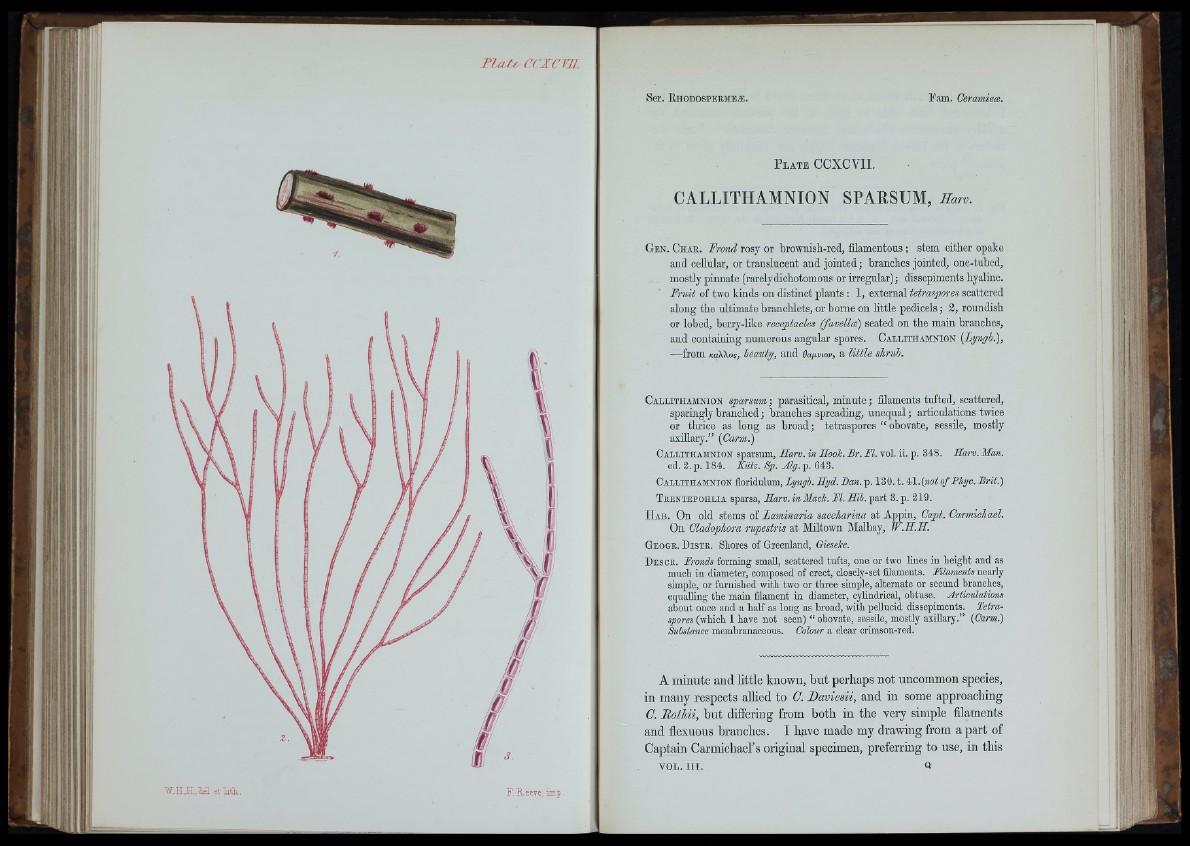
i - 1:
if I
Tîii
P l a t e CCXCVII.
CALLITHAMNION SPARSUM, i-iaw.
G e n . Ch a r . Frond rosy or brownish-red, filamentous ; stem either opake
and cellular, or translucent and jo in ted ; branches jointed, one-tubed,
mostly pinnate (rarelydichotomous or irregular); dissepiments hyaline.
F ru it of two kinds on distinct plants : 1, external tetraspores scattered
along th e ultimate branchlets, or borne on little pedicels ; 2, roundish
or lobed, berry-like receptacles (favelloe) seated on th e main branches,
and containing numerous angular spores. Ca llithamnion [Lyngb.),
■—from mXXoi, beauty, and Bagviop, a tittle shrub.
Callithamnion sparsum ; parasitical, minute ; filaments tufted, scattered,
sparingly branched ; branches spreading, unequal ; articulations twice
or thrice as long as b ro ad ; tetraspores “ obovate, sessile, mostly
axillary.” [Carm.)
C a l l i t h a m n i o n sparsum, Harv. in Hook. Br. M. vol. ii. p. 348. Harv. Man.
ed. 2. p. 184. KiiU. Sp. Alg. p. 643.
C a l l i t h a m n i o n floridulum, lyngb. Hyd. Ban. p. 130. t. i\.[n o t of Bhyo. Brit.)
T r e n t e p o h l i a sparsa, Harv. in Mack. M. Hib. part 3. p. 219.
H a b . On old stems of Laminaria saccharina a t Appin, Capt. Carmichael.
On Cladophora rupestris at Miltown Malbay, W .H .H .
G e o g r . D i s t r . Shores of Greenland, Gieseke.
D e s c r . Fronds forming small, scattered tufts, one or two lines in height and as
much in diameter, composed of erect, closely-set filaments. Mlaments nearly
simple, or furnished with two or three simple, alternate or secund branches,
equalling the main filament in diameter, cylindrical, obtuse. Articulations
about once and a half as long as broad, with pellucid dissepiments. Tetraspores
(which I have not seen) “ obovate, sessile, mostly axiUary.” [Carm.)
Substance membranaceous. Colour a clear crimson-red.
A minute and little known, but perhaps not uncommon species,
in many respects allied to C. Daviesii, and in some approaching
C. Botliii, but differing from both in the very simple filaments
and flexuous branches. I have made my drawing from a part of
Captain Carmicliael’s original specimen, preferring to use, in this
VOL. I I I . Q
i .
ii'